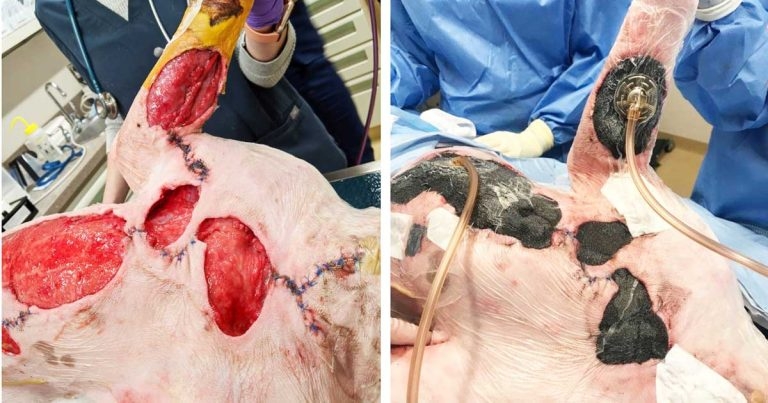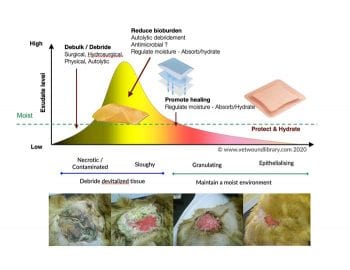3 Nov 2020
Georgie Hollis BSc, details considerations on innovations and research in this field.

Humans have adopted tools through millennia to influence and take advantage of their environment.
Wound management would have been an early part of our evolution, and has been shown to be a source of bonding and of societal importance in chimpanzees and great apes over many decades of study.
It is even thought that those who find it irresistible to squeeze out pus and remove debris from others’ wounds may have led the way to medicine where the satisfaction of one benefits the other through healing – an unconscious win-win that is thought to have been a game changer in terms of human evolution1.

Pain, redness, swelling, and heat attributed to acute and chronic inflammation have been observed and respected for centuries. Inflammation clearly documented by Hippocrates in 400BC described the colours, exudate and slough we observe as signs of inflammation and possible infection. These signs and stages have been consistently described through the years2.
Hippocrates also recommended cleansing wounds with boiled water, and removing foreign objects and devitalised tissue to help wounds progress. These are the same principles used today for optimal healing (Figure 1).
In the mid-1500s Ambroise Paré, a barber surgeon, was at the forefront of medicine and surgery, the very latest technology for management of wounds caused by gunfire being the use of boiling oil and cauterisation.
Only when Paré’s supplies ran low did he resort to his ancient textbook of Roman medicine. He dubiously applied the mixture of egg yolk, oil of roses and turpentine to the soldiers’ wounds3. His two test groups provided real evidence that showed him his new technology had poorer outcomes than that of his more gentle Roman recipe.
The wounds healed more quickly, less complications occurred and the patients were more comfortable. These key measures are still used to assess wound products today.

Paré immediate changed the way he worked, relying on his own experience alongside the evidence he had witnessed. He is known for the phrase “I dress the wounds, God heals them” – a statement reflected in Roman texts as “medicus curat, natura sanat”, meaning “the physician cares, nature heals”. Perhaps it’s time for another 500-year renaissance?
With more and more high-tech offerings in the veterinary arena it is easy to be impressed by the jargon and to forget what the product is actually offering. The aims of wound management should be the mantra that guides decision-making at each stage of wound progression.
When choosing a product or surgical technique, it should help you achieve the following goals:
Advanced wound care (as it has been coined) was born out of the need to economise on the cost of human health care4.
With 2.2 million people each year in the UK the cost of chronic non-healing wounds is a staggering £5.3 billion. To avoid a huge burden in hospital care, 87% of these patients are treated in the community using products that are chosen to create the optimal wound environment based on the phase of healing they are in.
The most recent evolution of surgical techniques and wound management could not exist without three “recent” advancements:
Finding good-quality evidence in favour of a specific wound management product or technique is a very challenging task. Not only are wound presentations so varied that a test group is near impossible, but the cost to provide a definitive outcome would be both ethically and financially unviable.

No one product creates the optimal environment for all healing phases to occur and these phases vary widely as healing progresses, depending on the type of patient, the type of wound and the inhibitors that are present5. To coordinate studies effectively within this range of variables is exceptionally challenging.
While high-level randomised controlled trials (RCTs) and meta-analysis do exist for individual product components – such as antimicrobials,foams and hydrogel – theyare rarely comprehensive in terms of comparative methods, adaptation forthe phase of healing or the range of indications forwhich the productsare applicable.
If you are searching for the latest technology for wound management you need look no further than military medicine. As has always been the case it is in battlefield trauma that we create a crucible of medical innovation. As life and limb‑saving devices and knowledge evolves, it is perfectly reasonable to assume many will have value in veterinary practice.

In line with Hippocrates’ experience, one of the most powerful steps in wound management is wound bed preparation; that is, lavage and debridement to allow for optimal proliferation6. In terms of technical advancement, the Versajet hydrosurgery system is a big step forward in our ability to carefully and selectively debride non‑viable tissue (Figure 2).
The Versajet system combines a vacuum pump and individual handset (intended for single use) that enables a jet of saline to be projected through the tip of the handset to achieve a Venturi effect over the wound (Figure 3).
The Venturi effect is much like a horizontal tornado over the wound bed that can be adjusted in power to achieve either a gentle clean or surgical removal of tissue.
Its role in veterinary practice has already proved helpful – particularly in equine standing surgery. It enables a contaminated wound to be thoroughly debrided with the ability to remove ingrained dirt and tissue at a level that can not be achieved with lavage and a scalpel.

Figures 4 and 5 illustrate the Versajet in use on a deep penetrating heel wound and the outcome at two months. The horse was cast for 10 days following debridement with the Versajet and went on to heal without complication, although the original prognosis was guarded due to the structures involved (case courtesy of Breda McDonagh while at Seadown Veterinary Group).
The negative points of this device are firstly that the manufacturer does not provide any field or service support for the unit – the rationale being that a potential risk of cross‑contamination exists from veterinary equipment serviced in the same building as systems due to be returned to human health care.
The second issue is the handsets. These are intended to be single use and are more than £350 each, but numerous vet practices have successfully reused handsets up to six times with very careful preparation and sterilisation techniques.
Power units are available to purchase second hand, but be aware that the Versajet I (a blue unit) is now obsolete – many are available, and cheaply, but the handsets are no longer made and the only ones are virtually non‑existent. The Versajet II (an orange unit) is more expensive, but a good investment, with handsets readily available.

A smooth transition from the inflammatory to the proliferative phase is hindered by the accumulation of dead tissue and bioburden, while movement and interference will disrupt newly formed tissue, reducing the rate of healing further. This is the case with some of the very large and challenging traumatic wounds that negative pressure wound therapy (NPWT) was developed to assist.
Rather than having to replace dressings multiple times a day – risking contamination, patient distress, pain and tissue damage – NPWT enables the wound to remain sealed, while a vacuum pump draws exudate away from the wound bed into a discrete canister. Not only can the exudate be measured and monitored to indicate progression, but the patients remained comfortable, with significant improvements in quality of life as their wounds healed.
While the original vacuum units were fairly large and noisy, they have been superseded with smaller (even disposable) units that can run for up to 15 days at an optimal 80mmHg to 120mmHg.
A range of controlled studies are headed up by Bryden Stanley DVM, associate professor at Michigan State University. She has demonstrated that a range of open wounds managed with NPWT after debridement/surgical excision achieved a healthy bed of granulation tissue ready for reconstruction in less time than those managed with the control of conventional moistened gauze7,8. The benefits (other than an unhindered progression to granulation) include reduced intervention and less anaesthetic events.
Subsequent experience with NPWT across many academic and referral centres has proven that this device has a wide application in veterinary practice. It has now been shown to be equally helpful in assisting with graft take and reducing seroma formation in reconstructed wounds (Figure 6).
Ideally in addition:
NPWT does have its shortcomings. The adhesive film that sticks around and over the wound needs to create an airtight seal. This can be a huge challenge in veterinary patients as the adhesives are most suited to humans. Owners will need to be aware that a very wide clipping margin may be required to achieve a good seal and loss of vacuum or blockage will reward you with an alarm, regardless of the hour – day or night.
With “true” RCTs a near impossibility when it comes to evaluating wound dressings and devices, we have to rely on smaller trials and anecdotal evidence to influence our choice.
Many companies will provide a portfolio of single-user testimonials to justify their product use in veterinary practice, but this is not true evidence. Pay attention to the details and remember that a case study should only illustrate what is proven by prior research.
In Europe, CE marking of medical devices ensures safety and clinical standards are met, but they do not apply to products used for veterinary use. Products imported from outside the EU for veterinary use may also lack regulatory controls, meaning the product may not meet our most basic expectations of sterility, traceability or ethics.
We have a duty of care to insist on some basic standards for our patients, as would be the case with products used on humans (Panel 1).
With the evolution of artificial intelligence (AI) and algorithms that promise to make our world easier being developed, we can hope for a quick fix. But don’t hold your breath – AI relies on the knowledge we give it and we definitely haven’t mastered this subject yet.
As humans managing wounds in the same way we have done for millennia, we are gloriously unaware of how incredibly complex our decision-making is.
We can all recognise the stages of healing as Hippocrates did and apply knowledge to creatively adapt the tools we have available to improve our situation. Like Paré.